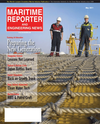
Page 37: of Maritime Reporter Magazine (May 2011)
Training & Education Edition
Read this page in Pdf, Flash or Html5 edition of May 2011 Maritime Reporter Magazine
May 2011 www.marinelink.com 37
Implementation of the ECDIS concept forces a complete change in the way nav- igational processes are carried out. In- stead of traditional paper charts and tools like divider, parallel ruler, and pencil, navigators should now be thoroughly fa- miliar with the interface and functions of an ECDIS installed on-board.
Training is the key to success when a shipowner decides to invest in ECDIS. It is a core element of an efficient plan for a safe and cost-effective transition from paper charts to ECDIS. Starting January 2012, all bridge officers must have Flag
State approved Generic ECDIS training, e.g. Flag State approved IMO Model
Course 1.27. According to the ISM
Code, Additional equipment-specific training for the ECDIS type in use on- board is required for every ship.
The IMO Standards for Training Certi- fication and Watchkeeping (STCW) re- quire an officer on watch to possess a “thorough knowledge of and ability to use navigational charts and publications” and also “skills and ability to prepare for and conduct a passage, including inter- pretation and applying information from charts, must be evident”. STCW is cur- rently written around paper charts but it is clearly stated in the SOLAS convention that “ECDIS is considered to be included under the term charts”. For some Flag
States it is entirely evident that if ECDIS is in use as the primary means of naviga- tion, the user must demonstrate the same degree of knowledge as when working on paper charts. Therefore the officer of, for example, an Isle of Man or UK registered ship needs to have an IMO Model Course 1.27 certificate.
According to the Manila Amendments,
STCW now includes specific mandatory requirements for certification of officers with regard to the use of ECDIS to main- tain the safety of navigation, including knowledge of the capability and limita- tions of ECDIS operations, with thorough understanding of ENC data, data accu- racy, presentation rules, display options and other chart data formats; the danger of over-reliance on, and familiarity with the functions of ECDIS required by per- formance standard in force; and profi- ciency in operation, interpretation and analysis of information obtained from
ECDIS. Training should incorporate the use of ECDIS simulation equipment and conform to the standards specified in the guidance. It should create a real-time op- erating environment, including naviga- tion control and communications instrumentation and equipment appropri- ate to the navigation and watchkeeping tasks to be carried out and the maneuver- ing skills to be assessed. It should also re- alistically simulate ‘own ship’ characteristics in open-water conditions, as well as the effects of weather, tidal stream and currents.
The second important regulation with regards to ECDIS training is the IMO’s
Transas Helps Forward
ECDIS Training

 36
36

 38
38
